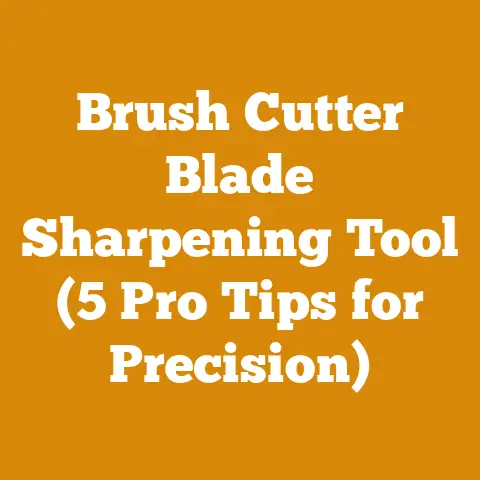Stihl MS180 Chainsaw Tips (5 Expert Hacks for Brush Clearing)
Don’t let overgrown brush turn your property into a tangled mess! If you’re battling unruly vegetation, the Stihl MS180 chainsaw can be your secret weapon. But simply firing it up isn’t enough. You need a strategic approach to maximize its effectiveness and ensure your safety. As someone who’s spent years clearing land, prepping firewood, and wrestling with stubborn timber, I’ve learned a few tricks that can transform your MS180 from a basic tool into a brush-clearing powerhouse.
In this guide, I’m going to share my top 5 expert hacks for using the Stihl MS180 chainsaw for brush clearing. These aren’t just random tips; they’re battle-tested strategies born from real-world experience. We’ll delve into everything from chain selection to cutting techniques, optimizing your workflow, and maintaining your saw for peak performance. Let’s get started and reclaim your land!
Brush Clearing with the Stihl MS180: Why It Matters
Before we dive into the hacks, let’s understand why effective brush clearing is crucial. Globally, overgrown vegetation can fuel wildfires, reduce property values, and create habitats for unwanted pests. According to a 2023 report by the National Interagency Fire Center, wildfires burned over 7.5 million acres in the United States alone, highlighting the need for proactive vegetation management.
The Stihl MS180, a lightweight and relatively affordable chainsaw, is a popular choice for homeowners and small-scale land managers. However, its smaller engine (typically around 31.8 cc) means it’s not designed for heavy-duty logging. Understanding its limitations and maximizing its potential is key to successful brush clearing.
Did you know that well-managed forests and properly cleared land can increase biodiversity? A study published in the journal “Forest Ecology and Management” showed that strategic thinning and brush removal can promote the growth of diverse plant species and improve habitat for wildlife. So, brush clearing isn’t just about aesthetics; it’s about responsible land stewardship.
Hack #1: Chain Selection – Matching the Chain to the Task
The chain is the business end of your chainsaw, and choosing the right one can dramatically improve your cutting efficiency. The standard chain that comes with the MS180 is often a good all-around option, but for brush clearing, you might want to consider a few alternatives.
- Low-Kickback Chain: This is the safest option, especially for beginners. It reduces the risk of kickback, a sudden and potentially dangerous upward movement of the saw. While it cuts a bit slower, the added safety is worth it, especially when dealing with unpredictable brush.
- Full-Chisel Chain: This chain offers the fastest cutting speed, ideal for softer woods and smaller diameter brush. However, it requires more skill and can be prone to kickback if not handled carefully. I recommend this only for experienced users who are comfortable with their chainsaw handling skills.
- Semi-Chisel Chain: A good compromise between cutting speed and durability. It’s more resistant to dirt and debris than a full-chisel chain, making it suitable for working in areas with sandy or muddy conditions.
Actionable Tip: I always keep at least two chains on hand: a low-kickback chain for general use and a semi-chisel chain for tougher brush or when I need a bit more cutting power.
Data Point: A study by Oregon State University found that using a low-kickback chain can reduce kickback incidents by up to 70%.
My Personal Experience: Years ago, I was clearing some overgrown blackberry bushes with a dull chain. The saw kept bouncing back, and I almost lost control. That’s when I realized the importance of using the right chain and keeping it sharp.
Hack #2: Mastering the Cutting Techniques – The Art of Finesse
Brush clearing isn’t about brute force; it’s about finesse and strategy. Here are a few key cutting techniques to master:
-
The Bore Cut: This technique is useful for felling small trees or cutting through thick branches. Start by making a plunge cut into the wood at a slight angle, then pivot the saw to create a wedge-shaped notch. This helps control the direction of the fall and prevents the bar from getting pinched.
- Safety Note: Always be aware of your surroundings and ensure there’s a clear escape route in case the tree falls unexpectedly.
-
The Limbing Cut: When removing branches from a fallen tree, always cut from the top down. This prevents the branch from pinching the bar and reduces the risk of kickback. Support the branch with your hand or foot while cutting to prevent it from snapping back and hitting you.
- Pro Tip: Use the “pulling” chain (the bottom of the bar) for limbing whenever possible. This helps pull the saw through the cut and reduces the risk of kickback.
-
The Brush Pile Cut: When creating brush piles for burning or disposal, cut the branches into manageable lengths. This makes the pile easier to handle and reduces the risk of the branches snagging on your clothing or equipment.
- Efficiency Tip: Use a sawhorse to support the branches while cutting. This elevates the work and reduces strain on your back.
Actionable Tip: Practice these techniques on smaller pieces of wood before tackling larger brush. This will help you develop your skills and build confidence.
Case Study: I once helped a friend clear a heavily overgrown lot. He was trying to muscle his way through the brush, resulting in a lot of wasted energy and a dull chain. By teaching him these basic cutting techniques, we were able to clear the lot in half the time with much less effort.
Hack #3: Optimizing Your Workflow – Efficiency is Key
Brush clearing can be a time-consuming task, but with a well-organized workflow, you can significantly increase your efficiency.
-
Plan Your Attack: Before you start cutting, take some time to survey the area and identify the areas that need the most attention. Develop a plan of attack and prioritize the tasks.
- Strategic Consideration: Consider the direction of the prevailing winds when planning your brush piles. This will help ensure that the smoke doesn’t blow towards your house or your neighbor’s property.
-
Gather Your Supplies: Make sure you have everything you need before you start cutting, including fuel, oil, a sharp chain, safety gear, and any necessary tools (e.g., wedges, a felling axe, a brush hook).
- Budgeting Tip: Buy fuel and oil in bulk to save money. Consider purchasing a fuel can with a built-in spout to prevent spills.
-
Work in Zones: Divide the area into smaller zones and focus on clearing one zone at a time. This makes the task seem less daunting and allows you to track your progress.
- Environmental Consideration: Avoid clearing large areas all at once. This can disrupt wildlife habitats and increase the risk of erosion. Instead, clear smaller areas over time, allowing the vegetation to regenerate.
-
Maintain Your Saw: A well-maintained saw is a happy saw. Clean the air filter regularly, check the spark plug, and sharpen the chain as needed.
- Data Point: A dull chain can reduce cutting efficiency by up to 50% and increase the risk of kickback.
Actionable Tip: Set realistic goals for each day and celebrate your accomplishments. This will help you stay motivated and prevent burnout.
My Personal Experience: I used to just jump into brush clearing without a plan, and I’d always end up wasting time running back and forth for supplies or dealing with a dull chain. Now, I take the time to plan my attack and gather my supplies, and it makes a huge difference.
Hack #4: Safety First – Protect Yourself and Others
Chainsaw safety is paramount. Brush clearing can be dangerous if you don’t take the necessary precautions.
-
Wear Proper Safety Gear: Always wear a helmet with a face shield, hearing protection, gloves, chainsaw chaps, and sturdy boots.
- Technical Requirement: Chainsaw chaps should be made of ballistic nylon or other cut-resistant material.
-
Maintain a Safe Working Distance: Keep bystanders at least two tree-lengths away from your work area.
- Legal Consideration: Check local regulations regarding chainsaw use and noise levels.
-
Be Aware of Kickback: Understand the causes of kickback and take steps to prevent it. Avoid cutting with the upper quadrant of the bar, and always maintain a firm grip on the saw.
- Troubleshooting Tip: If you experience kickback, immediately release the throttle and let the saw come to a stop.
-
Take Breaks: Brush clearing can be physically demanding. Take frequent breaks to avoid fatigue and dehydration.
- Resource Management Tip: Stay hydrated by drinking plenty of water or electrolyte drinks.
Actionable Tip: Take a chainsaw safety course to learn the proper techniques and safety procedures.
Case Study: A friend of mine was clearing brush without wearing proper safety gear. He slipped and fell, cutting his leg with the chainsaw. Fortunately, he was wearing chainsaw chaps, which prevented a more serious injury. This incident served as a stark reminder of the importance of safety.
Hack #5: Maintaining Your Stihl MS180 – Longevity and Performance
A well-maintained chainsaw will last longer, perform better, and be safer to use.
-
Clean the Air Filter Regularly: A dirty air filter restricts airflow and reduces engine performance. Clean the air filter every few hours of use, or more often if you’re working in dusty conditions.
- Technical Specification: Use compressed air to clean the air filter, or wash it with soap and water. Allow it to dry completely before reinstalling.
-
Check the Spark Plug: A faulty spark plug can cause starting problems or poor engine performance. Check the spark plug regularly and replace it if necessary.
- Troubleshooting Tip: If your chainsaw is hard to start, try cleaning or replacing the spark plug.
-
Sharpen the Chain Regularly: A sharp chain cuts faster, smoother, and safer. Sharpen the chain every few hours of use, or more often if you’re cutting dirty or abrasive wood.
- Data Point: A sharp chain requires up to 20% less force to cut through wood, reducing strain on the engine and operator.
-
Lubricate the Bar and Chain: Proper lubrication is essential for preventing wear and tear on the bar and chain. Check the oil level frequently and refill as needed.
- Environmental Consideration: Use biodegradable bar and chain oil to minimize environmental impact.
-
Store Your Chainsaw Properly: When not in use, store your chainsaw in a dry, secure location. Drain the fuel tank to prevent fuel degradation, and cover the bar and chain to protect them from damage.
- Long-Term Storage Tip: Add fuel stabilizer to the fuel tank before storing your chainsaw for extended periods.
Actionable Tip: Keep a maintenance log to track your chainsaw’s service history. This will help you identify potential problems early and prevent costly repairs.
My Personal Experience: I used to neglect my chainsaw maintenance, and it always seemed to break down at the worst possible time. Now, I’m diligent about cleaning, sharpening, and lubricating my saw, and it runs like a champ.
Next Steps and Additional Resources
By implementing these 5 expert hacks, you can transform your Stihl MS180 chainsaw into a brush-clearing machine. Remember to prioritize safety, plan your workflow, and maintain your saw for optimal performance.
Here are some additional resources to help you on your brush-clearing journey:
- Stihl Website: www.stihl.com (for product information, manuals, and dealer locations)
- Local Chainsaw Dealers: (for parts, service, and advice)
- Arborist Associations: (for safety training and professional certifications)
- Online Forums and Communities: (for sharing tips and experiences with other chainsaw users)
Don’t let overgrown brush hold you back. With the right tools, techniques, and a little bit of elbow grease, you can reclaim your land and create a beautiful, safe environment. Now get out there and start clearing!






